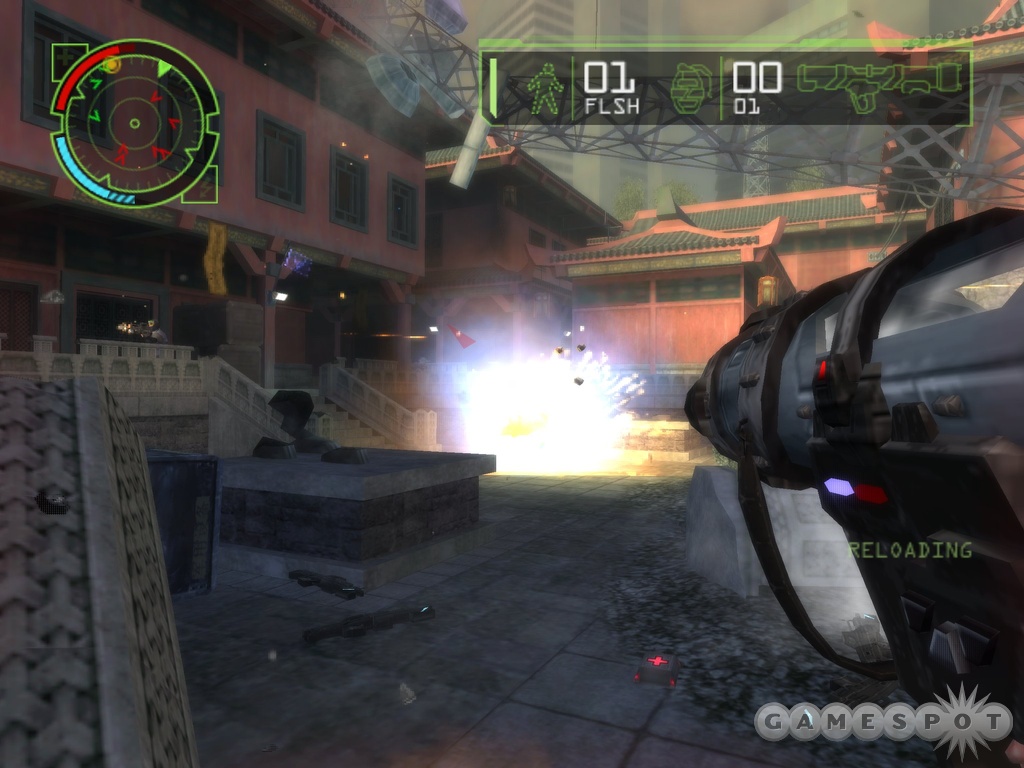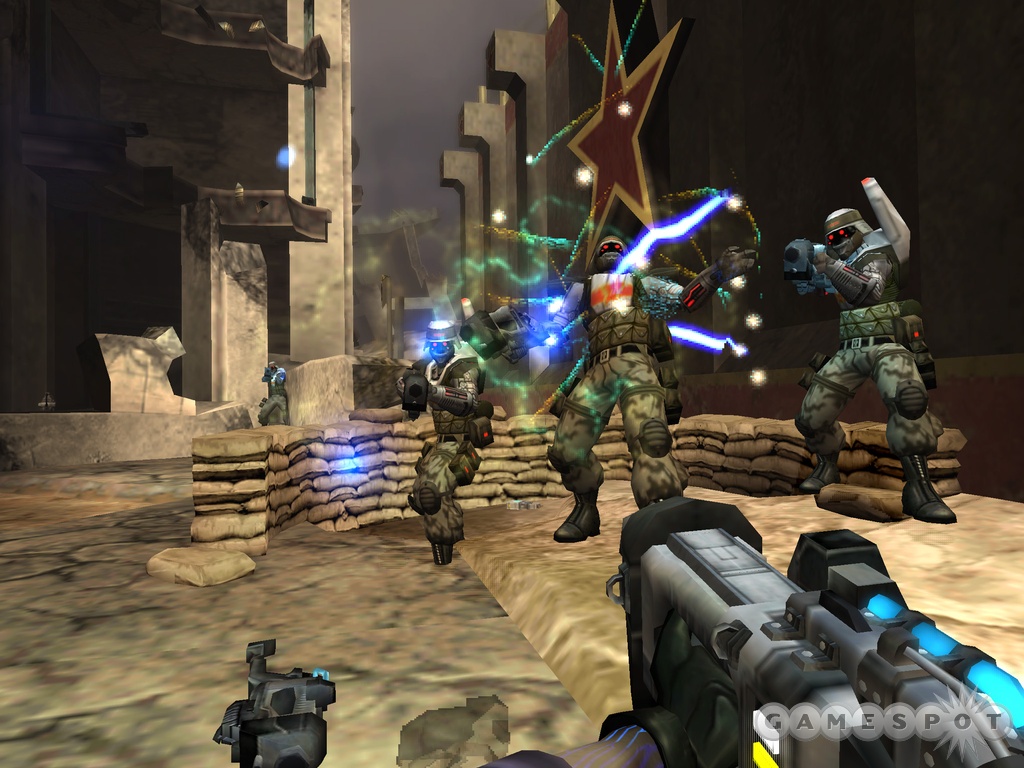Project: Snowblind Q&A
Designer Zak McClendon gives us the lowdown on Crystal Dynamics' upcoming futuristic shooter.
Project: Snowblind is a new futuristic first-person shooter in development for the PS2 and Xbox at Crystal Dynamics. Initially, it was rumored that the team was working on a new, console-exclusive Deus Ex title, but as it turns out, the Crystal D folks happen to be making an original game with its own flavor. We pinned down designer Zak McClendon to find out what will make this new technology-driven shooter tick.
GameSpot: What was the impetus for Project: Snowblind? How did the original concept come about?
Zak McClendon: We're all huge fans of FPS games and we saw the chance to do something really unique. We wanted to combine the drama and large-scale battles you see in World War II FPS games with the open-ended combat and huge arsenal you see in less linear shooters. The result is a game that constantly gives the player new options, weapons, and tools to tackle overwhelming odds and come out on top.
GS: How long has the project been in development?
ZM: We finished preproduction in February, so we've been in full production for about 11 months.
GS: Does Snowblind have any actual ties to the Deus Ex series?
ZM: Warren Spector and the team at Ion Storm were amazingly helpful at an early point in the project, and much of their help and inspiration can still be seen in the huge number of weapons, abilities, and gadgets we give the player and in the multiple ways players will be able to meet the game's challenges. As the game moved forward, though, Project: Snowblind quickly evolved its own unique identity.
GS: From where did you draw inspiration for the game's world and storyline?
ZM: We've tried hard to capture the feel and heroism of the World War II era, while injecting it with sci-fi elements and a bit of the fantastic. Nathan Frost's Liberty Coalition may be a fictitious entity, but we drew inspiration from movies like Saving Private Ryan and other World War II classics to create a story that's full of character and personal heroism--it's not just about fighting.
GS: In your estimation, what makes Project: Snowblind different from other first-person shooters?
ZM: Most importantly, it's the weapons and player abilities. The sheer wealth of options available to the player at every step is amazing. At any point, Nathan Frost can have a primary weapon, a secondary thrown weapon, and an enhanced special ability, referred to as an "augmentation." Although the player will start out with some genre favorites--the shotgun, the rocket launcher, and so on--every weapon in the game offers a unique alternate fire mode, effectively doubling your arsenal. These aren't just more-powerful versions of the primary fire modes, either. The shotgun, for example, fires a sheet of sticky bombs that adhere to any target. Shoot a few of these into an enemy and watch him panic. If he runs back to his friends, you get a few extra takedowns. If he runs back your way, you'd better look out.
As you progress through the game, Frost will gain more of the futuristic weapons, like the flechette gun, which fires high-energy rounds capable of bouncing around corners, and has an alternate fire mode that shoots out an intelligent swarm of attack drones. These drones can track targets you can't even see yet and cause mass hysteria among a group of enemies. Or the HERF gun, which is effectively an electric flamethrower. Hit one target with the primary fire and it will arc to other nearby targets, causing a chain reaction that can take down a crowd in seconds. The alternate fire mode on that one is an electric mine that will stick in place and zap anyone who comes near, before eventually exploding.
The secondary weapons offer even more options. Blind your enemies with a flashbang, immobilize them with a gas grenade, or block their attacks entirely with a riot wall--a portable cover that the player can place anywhere. Once you add in the augmentations, you'll begin to see just how many options for attack and defense Project: Snowblind offers. We tried to make sure our arsenal would constantly be giving players something new to try out, and reward experimentation with unexpected results in battle.

The battles are another thing we're extremely proud of. We really wanted give the player actual war zones--not a continual progression of three to five enemies popping out of side passages. Project: Snowblind's large-scale battles push half a dozen friendly troops and about triple that number of enemies at any time, while maintaining a consistent frame rate.
The battles themselves are stunning, and, on the visual side, we think Snowblind really stands out from a lot of the FPS games on the market. There are a lot of gorgeous shooters out there, but almost all of them take place in the olive drabs of World War II, inside rusty space stations, or in grim dystopian futures. Snowblind's still got plenty of grit in its atmosphere, but we worked hard to ensure we choose settings and color palettes that would help the game stand out in an extremely competitive genre. Players will find themselves in such diverse locations as a makeshift military outpost built inside a Buddhist temple or a giant opera house converted into a political internment camp.
GS: Can you tell us about some of Frost's experimental implants, and what impact they'll have on the gameplay?

ZM: Beyond the standard equipment for an augmented supersoldier (GPS radar, enhanced speed and strength, and so on), Frost will also unlock five specific abilities to help in his fight against the Republic. These range from defensive abilities, such as "cloak" and "ballistic shield," to offensive ones, such as "electrical storm," which fires off a self-guided bolt of lightening that will travel from enemy to enemy to thin out their ranks while you finish them off with your main weapons (or hide, if you're that sort of player). The augmentations let players further customize the game to their own play styles. If you're a cautious player, you might rely more on "enhanced vision" to spot enemies through walls and then take them out with the rail laser, without exposing yourself. If you're more of a run-and-gun player, you might fall back on "reflex boost" to slow time and give yourself an edge in battles.
As the single-player campaign plays out, and the odds become less even, players will have to rely on these abilities to make it through--but how they do it is up to them.
GS: We understand that Snowblind will be composed of "total war" and "infiltration" missions. Could you explain the differences between these two mission types, and tell us roughly what percentage of the game will be spent in each?
ZM: Because of the sheer intensity of our large-scale battles (the "total war" missions), it was important that we provide players with some breathing room and a chance to slow down and play with some of their new toys. Infiltration missions are a bit more covert. Frost heads into enemy territory alone and must face security systems, patrolling guards, alarms, and other unique challenges. The two mission types aren't unique "styles," really, but they do present differing challenges and opportunities to use different abilities. If you want to try infiltrating an enemy base by running in, guns blazing, you can do that, though you might have a tougher time of it.
Project: Snowblind's single-player missions are pretty evenly split between large-scale warfare and covert infiltrations, but there are a couple of missions in the mix that don't fit in either category and are unique in their own right. And then there are some missions that are combinations of both "styles"--they might start out covert and end with a bang.
GS: What kinds of vehicles, mechs, or other machinery will you be able to control in the game?
ZM: Players will get a taste of our vehicles in the single-player campaign, where they'll be able to pilot mechanized walkers, cars, and combat buggies. The vehicles play an even more prominent role in multiplayer, with about half of our maps supporting vehicle gameplay. The single-player vehicles have been reworked for the multiplayer modes, so you'll be able to pilot two-seat vehicles, such as the Hydra combat buggy or the Titan tank, with a buddy in the gunner's seat. Add regular cars and the Ogre mechanized walker to the mix, and you've got some pretty hectic battles in store.
GS: How extensive will the multiplayer options be? What can you tell us about the class-based gameplay?
ZM: Naturally, we have the old standby games of deathmatch, team deathmatch, and capture the flag, but we've also got some more-interesting modes cooked up to provide more-complex team play and a deeper multiplayer experience. Some examples are tactical assault, which pits two teams against each other in a race to control strategic points before a final assault on the opposing base, and hunter, which gives one player every ability and weapon in the game while the others try to hunt him or her down. The current favorite around the office right now is demolition, which has both teams fighting for control over a single bomb that must be planted on the enemy's base--and then defended during the countdown--to score a point.

Just like in the single-player game, we've put a ton of effort into making sure our multiplayer component has plenty of depth to discover as players put more time into it. All our multiplayer modes are class-based, so players will start out choosing a unique loadout, with specific primary weapons, grenades, and augmentations. The augmentation for the class complements its weapon loadout and strategic role in the game. For example, the sniper class comes with the cloak augmentation, as well as flashbang grenades, making it a perfect choice for the sneaky player who likes avoiding direct firefights. The scout class comes with the speed augmentation, a shotgun, and the riot wall, and is great for getting up in an enemy's face and then making a quick getaway. Players should be able to find a class from the six available to suit their play styles or particular tactics. Beyond this, teams can mix and match the classes, which can to lead to some pretty unique strategies and tactics. It's these sorts of nuances that should keep people busy with Project: Snowblind's multiplayer for quite a while.
GS: What technology is powering the game? Will there be significant differences between platforms?
ZM: Project: Snowblind is using an engine developed in-house at Crystal Dynamics. Major differences between platforms will include exclusive multiplayer modes on the PS2 and the Xbox, as well as downloadable content for the Xbox.
GS: Thanks for your time.
Got a news tip or want to contact us directly? Email news@gamespot.com
Join the conversation